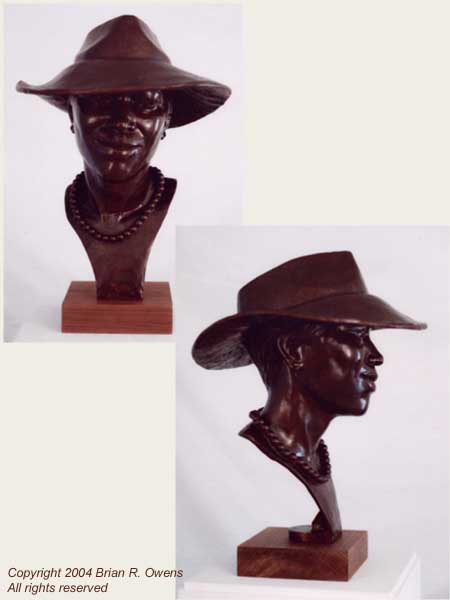 |
| Zora Neale Hurston 1891 - 1960 Commissioned by the African American Museum of the Arts, DeLand, Florida. Cast bronze, may be cast again, height=22", including base |
|
IMPUDENT and Given to Talking Back My take on Zora Neale Hurston, by Brian R. Owens America has been rediscovering Zora Neale Hurston, a writer who produced a remarkable body of work in the first half of the twentieth century. Zora Neale Hurston was a playwright, journalist, novelist, anthropologist, critic, short story teller and educator. Since her major works were reissued some twenty years ago, her work is now considered to be part of the national treasure. The Library of Congress holds her anthropological papers; Yale University holds the original handwritten manuscript of her most celebrated novel; Zora Neale Hurston's novel Their Eyes Were Watching God has been translated into several languages and has become part of the popular culture here in the states. Books by Zora Neale Hurston are considered required reading at several Universities. Nobel Peace Prize laureate Toni Morrison holds Zora Neale Hurston as one of the most significant writers this country has ever produced. Acclaimed author Alice Walker showed her respect by laying a headstone at her unmarked grave in 1973. Zora Neale Hurston was a black woman who made it into Who's Who in America, Current Biography, and Twentieth Century Authors in 1942 when blacks were not legally recognized as human beings in all states ... wow. But, who was she?. Zora Neale Hurston was born in 1891 to Lucy and John Hurston. John Hurston was an ambitious man who moved his young family from Alabama to Eatonville, Florida when Zora Neale Hurston was a child on the theory that life would be better here. He found Eatonville entirely by accident. Eatonville is this country's oldest surviving incorporated black city, formed in 1887 with a population of about 300 people. It is located just north of Orlando. It still has a black mayor, black fire department, black police department, black museum, black everything. Eatonville's story is vital to Zora Neale Hurston's story for it was there that her irreverent, impertinent, brilliant mind was formed. But the tools that black people used to navigate through their often dangerous world, their reserve and caution, were unnatural to Zora Neale Hurston and her father feared for her future. Her mother described her as "Impudent and given to talking back".* As a young woman she attended Howard University for a year or so, getting "A's" in the courses she liked and flunking the rest until one of her short stories entitled Drenched with Light was published in a 1924 issue of Opportunity, the magazine of the National Urban League. Her short story impressed influential people who who invited her to New York City to meet with other superb writers in 1924 at the start of what would come to be known as the Harlem Renaissance. In New York, Zora Neale Hurston became a friend and colleague of Langston Hughes and other luminaries, including artists of all types, musicians and great thinkers. Although she did not drink, she was usually the life of the party. Zora Neale Hurston was not beautiful by European standards, but she exuded a disarming charm and sense of humor. She was a student of attire and style. She lied constantly about her age but her emerging, enduring written voice spoke the truth as no-one had before. Zora Neale Hurston was sometimes misunderstood but always respected for her undeniable talent. Later in 1928, Zora Neale Hurston graduated from Bernard College. The mid 1930's to the early 1940's were her most prolific period and marked the height of her career. During this time she taught at North Carolina College for Negroes (now North Carolina Central University) and wrote many of the titles listed below. She loved Florida and wrote most of her published books here. Although her work was critically acclaimed, Zora Neale Hurston never prospered financially from the sale of her work. She was half a century ahead of her time. Zora Neale Hurston retired to live in Ft. Pierce, where she continued to write until she died in poverty in 1960 at the age of 69. Community members pooled money for her burial but could not afford a headstone. Thanks to a black deputy sheriff from the St. Lucie County Sheriff's Department, the papers that were in her home when she died were saved from a fire that was deliberately set by an eviction crew to hasten their job. These papers, which include handwritten manuscripts along with bills are now held and conserved by the University of Florida, Gainesville. The Zora Neale Hurston Festival of the Arts and Humanities (the Zora Festival) is held annually in late January in Eatonville, Florida. Leading writers, actors and scholars also meet during this time. Celebrities in disguise have been spotted as they eat, listen to music and buy artwork along with a crowd of thousands. ZORA NEALE HURSTON's work includes: Jonah's Gourd Vine Mules and Men Their Eyes were Watching God Tell My Horse Moses, Man of the Mountain Dust Tracks on a Road *p.27, Wrapped In Rainbows, The Life of Zora Neale Hurston, by Valerie Boyd, Simon & Schuster, 2003. WORKING METHOD FOR A POSTHUMOUS BRONZE PORTRAIT This bronze portrait of author Zora Neale Hurston was especially challenging because my own level of expectation was so high and the photographs that I used as references were poor. I worked from about eight photographs that show Zora Neale Hurston at various points in her life from a teenager to a woman in her sixties. Each photograph was different enough that they could have been photos of different women. This is a common challenge. The completed portrait is synthesized from the set of photos taken as a whole, not a single photo. The key is to identify the features of the face that make the face identifiable, render them correctly and then go for style and attitude. Zora Neale Hurston is a perfect example of a person who is so closely associated with accessories, namely her hats and pearls, that they have become as important as the features of her face and must be included in the bronze portrait. You might think that it's easier to sculpt a posthumous portrait since the subject is not here to provide a comparison. This is not necessarily true. In the case of Zora Neale Hurston, the posthumous portrait is the greater challenge because each one of her adoring readers has their own little image of her filed away in their mind. Thanks again, African American Museum of the Arts, DeLand, Florida for making this sculpture possible. |

